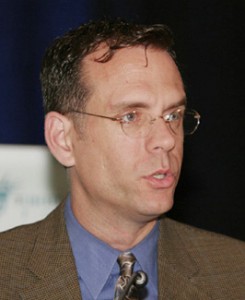OutRight: At What Price, Full Inclusion?
Principle and pragmatism in ENDA
Should gays wait for civil rights until transgendered people can be included? That’s the question in the recent controversy over the Employment Non-Discrimination Act (ENDA). The answer depends on how much weight one gives the concept of a single “GLBT community” against the practical need to make incremental progress in civil rights.
Rep. Barney Frank (D-MA) and leaders in the House of Representatives maintain that ENDA will pass if it is limited to protecting gay people from employment discrimination. But, they say, it cannot pass if it also includes protection for “gender identity,” a term that refers in part to the transgendered. Frank and House leaders might be wrong about this, or they might be too cautious, but nobody has yet offered a more reliable vote count.
Passage of ENDA is possible only because gay people have organized politically to educate Americans about homosexuality and to elect sympathetic representatives. When similar federal legislation was first proposed in 1974, it was an exotic cause. After more than three decades of hard work, the votes are finally there.
There has been no comparable effort—in terms of duration, intensity, or effectiveness—to educate or to organize for trans rights. This is partly because the idea is relatively new for most people. ENDA itself did not include “gender identity” until very recently. Trans protections have passed in a few liberal states, but we don’t have a liberal congressional majority.
Nevertheless, lots of activists and organizations are vowing to work to defeat ENDA unless it includes gender identity. They believe gay people should wait until “everybody” in the “GLBT community” is included.
On principle, they argue that all GLBTs transgress traditional ideas about men and women. Gays do so by being attracted to the same sex; the transgendered, by acting and appearing as the opposite sex. Gays and transgendered people also have the same enemies: those who believe in traditional and strict gender roles. It thus makes no more sense to pass ENDA without trans protection than it would be to pass ENDA without lesbian protection.
But this view is too simplistic. The differences between gays and the transgendered, in terms of daily living, are profound. Gays do not reject the sex into which they are born and do not necessarily reject many traditional gender expectations. There is some rejection of gender norms in both groups, but there are huge differences of degree. So saying that gays and transgenders have “gender nonconformity” in common is like saying Miami and Minneapolis have winter in common.
Yes, there are some common enemies. But unfortunately even many gay-friendly people still find the idea of, say, a male-to-female transsexual very unnerving.
As a matter of principle, then, it makes sense to deal with trans legal rights separately from gay rights far more than it would make sense to deal with the rights of gay men separately from the rights of lesbians. The idea of an indivisible “GLBT community” is thus more a philosophical aspiration than a practical reality.
That brings us to pragmatic considerations.
ENDA doesn’t “include” anybody if it can’t pass. Nobody knows how long it might take to educate Congress about trans issues. In the meantime, in 31 states there will be no job protection for gay people. Shall we make them wait a year? Five years? Forever?
Some have noted that even if a gay-only ENDA overcomes a filibuster in the Senate, President Bush might veto it. That’s certainly possible and maybe probable, but a trans-inclusive ENDA would make both Senate passage and presidential approval less likely. Even if Bush vetoed ENDA, simply winning in the House would be a historic victory. It would build political momentum for more advances later.
Progress in civil rights has never been an all-or-nothing proposition. If it were, we’d still be waiting to pass the Civil Rights Act of 1964, which protected blacks from job discrimination, but left out the aged and disabled people. When the law was expanded in 1991, but still excluded sexual orientation, gay people didn’t picket the NAACP.
Even an “inclusive” ENDA won’t include lots of groups subject to systematic discrimination, like homely, short, or overweight people. Other nonconformists often thought part of the GLBT community, like leather fetishists and sadomasochists, won’t be protected. Why shouldn’t we wait for them too?
Ironically, many of the activists demanding trans inclusion live in states where an incremental approach to gay and trans rights is well understood. California adopted gay civil rights laws long before trans protections. One of the groups opposed to a gay-only ENDA is the Empire State Pride Agenda, the New York gay-rights group, which just four years ago lobbied successfully for a gay-only state antidiscrimination law because a trans-inclusive one couldn’t pass.
The opposition to ENDA is coming mostly from a cadre of articulate, politically aware, and protected gay activists living in cocoons on the coasts and in large cities. They are imposing gender and queer theory on the lives of millions of gay Americans throughout the South, Midwest, and West. They charge that a gay-only ENDA manifests a selfish willingness to throw transgenders out of the boat.
Instead, the all-or-nothing ENDA manifests a self-satisfied willingness to sell the fly-over gays down the river. Hearts pure and integrity intact, elite activists who already have their rights will defend their high-minded principles right down to the last gay Alabaman.
Writing from the conservative side, Dale Carpenter began his column for OutSmart in 1994, when he lived in Houston. Now residing in Minneapolis, Carpenter is a University of Minnesota Law School professor.












Comments